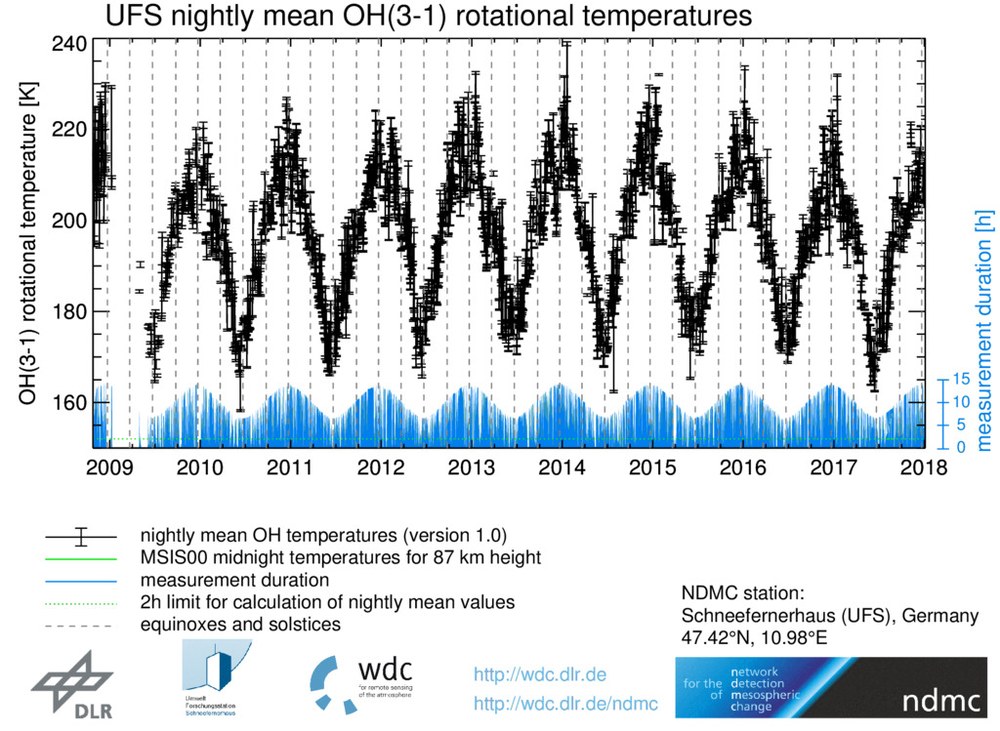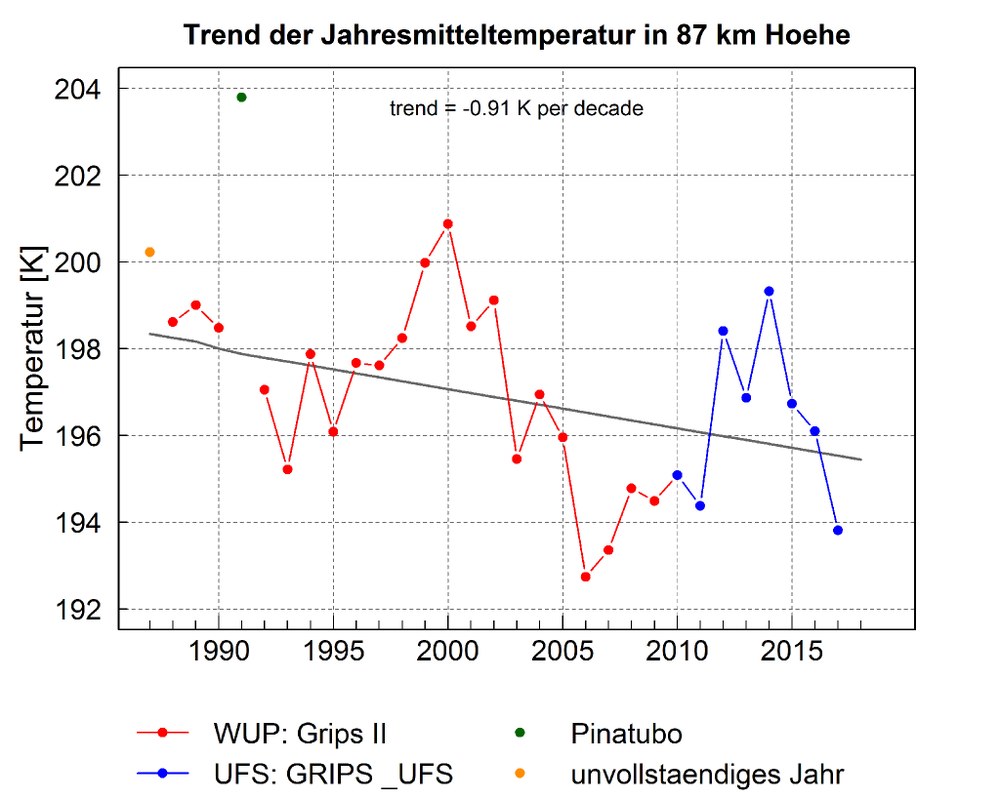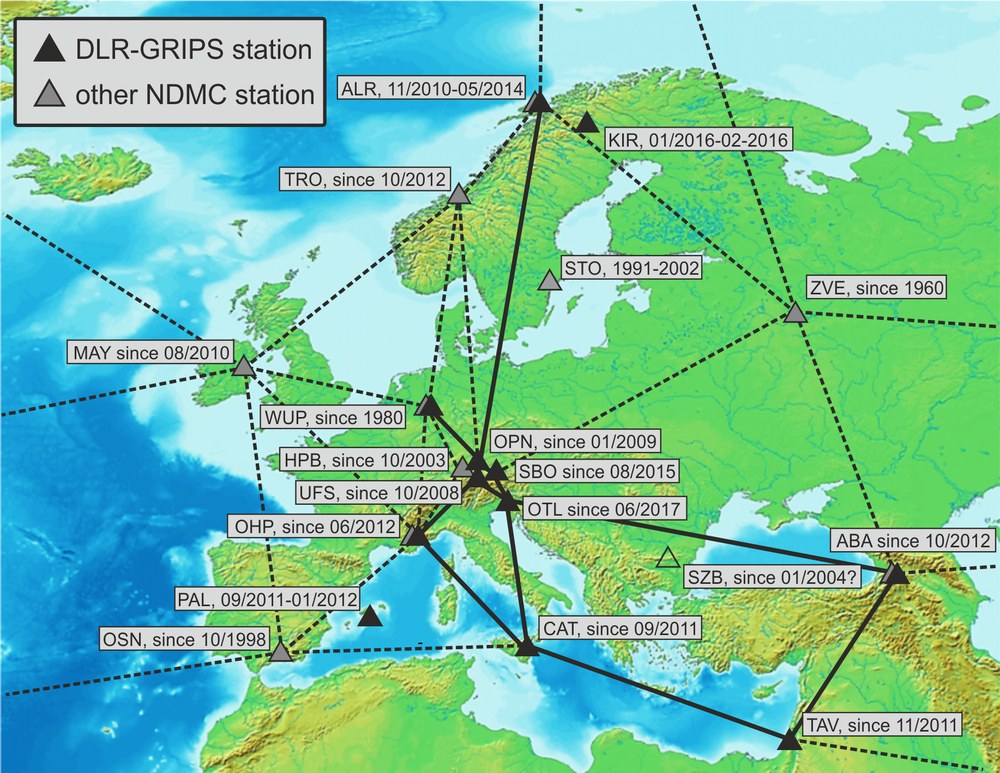2017 Third-coldest year since measurements began – in the mesopause


For Germany, 2017 was the third-coldest year since measurements started in 1987—but that was true only at 87 kilometres altitude. The temperature development there takes a course opposite to the one at Earth’s surface. This atmospheric region, the upper mesosphere, is at the focus of EOC interest because that is where changes that will take place in the atmosphere underneath can be detected and measured beforehand.
There are naturally glowing layers that exist in the mid-atmosphere at altitudes of 80 to 300 kilometres. This “airglow” is generated by chemical reactions between atoms and molecules that become ionised during the day by strong solar radiation. After a delay, the energy transferred in this way is again released as radiation, initiated by other reaction processes. At about 87 km hydroxyl molecules (OH) emit the resulting red and infrared light. This airglow can be measured from the ground with special spectrometers. GRIPS instruments (GRound-based Infrared P-branch Spectrometer) monitor airglow at wavelengths that are invisible to the human eye in the near-infrared range (1.52 to 1.50 micrometres). From the recorded spectra EOC scientists can draw conclusions about the ambient temperature at that altitude level. In the mesopause, temperature behaves opposite to what happens on the ground. In summer it is cold there, and in winter warm. The temperature reversal at this altitude is connected with the influence of atmospheric gravity waves on global circulation in the mid-atmosphere. Temperature changes in the lower atmosphere can thus also be revealed in the mesopause, but with the opposite signs, and stronger.
For that reason, EOC’s long-term time series of airglow measurements can be used for early detection of climate trends in the atmosphere. The EOC time series alone covers almost ten years and was collected by GRIPS instruments 5, 7 and 8. Since October 2008 they have monitored night airglow from the Schneefernerhaus environmental research station on Mount Zugspitze (Figure 1). Together with data from the University of Wuppertal (BUW) collected from1987 to 2010 (GRIPS 1 and 2), a 30-year time series has been generated that may well be unique worldwide.
Initial analysis of the time series shows that 2017 was the third-coldest year since recording began in 1987 (Figure 2). Only 2006 and 2007 were colder. In addition, the sunspot cycle can be identified in the annual mean temperatures. This variation in solar radiation at a periodicity of about 11 years causes a temperature change in the mesopause of about 4°C. Besides variations caused by the sun, in other words by an “external driver”, there are other variations in the cycle seen every two to four years. These can be traced back to internal fluctuations in the atmosphere like the quasi-biennial oscillation (QBO) or the El Nino Southern Oscillation (ENSO). They are part of the Earth System and one of the “internal drivers”.
Disregarding these cyclic variations, the temperature in the upper mesosphere appears to be decreasing long-term by about 1°C per decade (Figure 2), while at Earth’s surface the global mean temperature has risen by about 0.2°C during the same period. The changes in the upper levels are noticeably greater. Measuring them is, accordingly, a suitable way to identify coming changes in the atmosphere.
The instruments, the measurements, and the associated research were partially financed by the Bavarian State Ministry of the Environment and Consumer Protection, the European Union, and the German Ministry of Education and Research. In addition to the GRIPS reference station on Mount Zugspitze, EOC operates others in Europe (Figure 3), Asia and the Antarctic. These stations are linked to the EOC-coordinated international Network for the Detection of Mesospheric Change, NDMC, which participates in the United Nations global climate research programme.
Links
- Schneefernerhaus Environmental Research Station (UFS) on the Zugspitze mountain
- NDMC - Network for the Detection of Mesospheric Change
- A ground-based spectrometer equipped with an InGaAs array for routine observations of OH(3-1) rotational temperatures in the mesopause region
- Variability of the Brunt–Väisälä frequency at the OH* layer height

